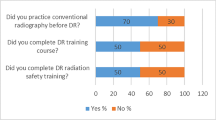Abstract
Students who are learning medical radiology undergo practical training on radiography in university labs or hospitals. However, when using radiation exposure and anthropomorphic phantom which concern the use of actual X-ray apparatus, the benefits of practical training can be limited due to difficulties in employing a variety of patient positions. This study will propose the implementation method of simulator in order to develop an unprecedented radiography training simulator. The study seeks to improve the quality of practical training by proposing a method for acquiring the image which will be used as a database in the simulator, as well as a method for creating an algorithm so that concerns of radiation exposure by students can be addressed, and limitations of practical training using anthropomorphic phantom can be eased. In the field of digital radiography, a simulation method that allows for examination procedures and images that are equal to those from an actual X-ray examination but without the exposure of X-rays is proposed. A suggestion is made on the method for creating an algorithm that uses images according to the changes in dose and size of images which are then used as part of a database in the radiography training simulator. A programming method that can bring corresponding images from images which were databased according to the examination procedures was proposed. In addition, a service or interchange of sustainable database is possible using an online service with accumulation of more diverse practical images. Furthermore, it can be built on so that images can be studied in a practical manner using smartphones. The use of a radiography training simulator should be able to provide higher quality practical training through repetition without the ethical issues arising from radiation exposure. It can become standardized way that remove the constraints of patient position when using an anthropomorphic phantom.






Similar content being viewed by others
References
Rosen, K. R. (2008). The history of medical simulation. Journal of Critical Care, 23(2), 157–166.
John, N. W. (2008). Design and implementation of medical training simulators. Virtual Reality, 12(4), 269–279.
Sonoda, M., Takano, M., Miyahara, J., et al. (1983). Computed radiography utilizing scanning laser stimulated luminescence. Radiology, 148(3), 833–838.
Dobbins, J. T, 3rd, Ergun, D. L., Rutz, L., et al. (1995). DQE(f) of four generations of computed radiography acquisition devices. Medical Physics, 22(10), 1581–1593.
Chotas, H. G., Dobbins, J. T, 3rd, & Ravin, C. E. (1999). Principles of digital radiography with large-area, electronically readable detectors: A review of the basics. Radiology, 210(3), 595–599.
Rowlands, J. A., Zhao, W., Blevis, I. M., et al. (1997). Flat-panel digital radiology with amorphous selenium and active-matrix readout. Radiographics, 17(3), 753–760.
Bacher, K., Smeets, P., Vereecken, L., et al. (2006). Image quality and radiation dose on digital chest imaging: Comparison of amorphous silicon and amorphous selenium flat-panel systems. AJR American Journal of Roentgenology, 187(3), 630–637.
Floyd, C. E, Jr, Warp, R. J., Dobbins, J. T, 3rd, et al. (2001). Imaging characteristics of an amorphous silicon flat-panel detector for digital chest radiography. Radiology, 218(3), 683–688.
Schaefer-Prokop, C., Uffmann, M., Eisenhuber, E., et al. (2003). Digital radiography of the chest: Detector techniques and performance parameters. Journal of Thoracic Imaging, 18(3), 124–137.
Huda, W., Rill, L. N., & Bruner, A. P. (1997). Relative speeds of Kodak computed radiography phosphors and screen-film systems. Medical Physics, 24(10), 1621–1628.
Abrahamson, S., Denson, J. S., & Wolf, R. M. (2004). Effectiveness of a simulator in training anesthesiology residents. 1969. Quality and Safety in Health Care, 13(5), 395–397.
Maran, N. J., & Glavin, R. J. (2003). Low- to high-fidelity simulation—A continuum of medical education? Medical Education, 37(Suppl 1), 22–28.
Ahlberg, G., Hultcrantz, R., Jaramillo, E., et al. (2005). Virtual reality colonoscopy simulation: A compulsory practice for the future colonoscopist? Endoscopy, 37(12), 1198–1204.
Kolkman, W., Van de Put, M. A., Van den Hout, W. B., et al. (2007). Implementation of the laparoscopic simulator in a gynecological residency curriculum. Surgical Endoscopy, 21(8), 1363–1368.
Berry, M., Lystig, T., Reznick, R., et al. (2006). Assessment of a virtual interventional simulator trainer. Journal of Endovascular Therapy, 13(2), 237–243.
Monsky, W. L., Levine, D., Mehta, T. S., et al. (2002). Using a sonographic simulator to assess residents before overnight call. AJR American Journal of Roentgenology, 178(1), 35–39.
Towbin, A. J., Paterson, B. E., & Chang, P. J. (2008). Computer-based simulator for radiology: An educational tool. Radiographics, 28(1), 309–316.
Kailas, A., & Ingram, M. (2009). Wireless aspects of telehealth. Wireless Personal Communications, 51(4), 673–686.
Yang, J. I., Ping, Z., Zheng, H., et al. (2006). Towards mobile ubiquitous service environment. Wireless Personal Communications, 38(1), 67–78.
Rezaee, A., Yaghmaee, M., & Rahmani, A. (2014). Optimized congestion management protocol for healthcare wireless sensor networks. Wireless Personal Communications, 75(1), 11–34.
Algaet, M., Noh, Z., Shibghatullah, A., et al. (2014). Provisioning quality of service of wireless telemedicine for e-health services: A review. Wireless Personal Communications, 78(1), 375–406.
Author information
Authors and Affiliations
Corresponding author
Rights and permissions
About this article
Cite this article
Choi, J.K., Kim, K.B. & Kim, G.J. Image Selection Algorithm Proposal for Digital Radiography Training Simulator. Wireless Pers Commun 89, 833–845 (2016). https://doi.org/10.1007/s11277-016-3247-3
Published:
Issue Date:
DOI: https://doi.org/10.1007/s11277-016-3247-3




